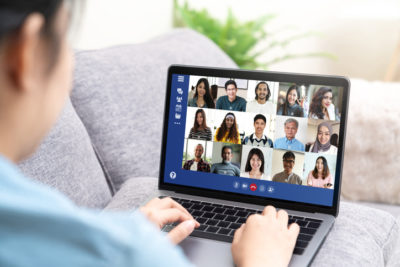
There are all kinds of reasons to start working remotely, from reduced commute time to fending off a global pandemic. It’s the latter that’s caused much of today’s workforce to experiment with remote work for the first time over the past several months — but even when this ongoing health crisis is over, the benefits of working from home won’t be ignored. This means it’s likely that many employees will opt to permanently work remotely. This leaves many HR leaders wondering: what does the future of human resources look like after COVID-19?
The Sudden Shift to Remote Work
Before COVID-19, fewer than 50% of companies had any kind of established remote work program, let alone an effective one. Today, more than half of the American workforce is working from home.
The shift happened almost overnight. As formerly co-located workforces went virtual, HR teams scrambled to support them in both expected and unexpected ways. Several months into the crisis, it’s still a learning process but the HR industry collectively has demonstrated impressive efficacy in easing this shift.

In fact, many companies have found remote work so successful that the change may stick indefinitely. Headlines like, “Never Going Back to the Office” and Twitter’s recently instated “Work from Home Forever” policy are early signs that COVID-19 will change the way we work for the long-term. A study recently released by Gallup found that a majority of American adults would prefer to continue working from home “as much as possible” following the crisis.
We consider this shift a welcome one. Remote employees cite higher productivity, working on average 1.4 days more per month than their in-office counterparts — and there seems to be no compromise on the quality of their work. Additionally, employers incur significantly lower overhead costs with a remote team. Though benefits abound, writing the rules for the new future of human resources will still take work, and leaders should be prepared to learn as they go.
We’re not psychics, but there are several elements of the HR function that will clearly be impacted by this historic pivot. In this article, we share five HR functions we anticipate will change after COVID-19.
5 Ways the Future of Human Resources Will Change After COVID-19
COVID-19 has already caused many companies to rethink the execution of traditional HR functions. As the future of human resources reveals itself to be increasingly centered around remote work, leaders will need to respond dynamically and refine the strategies they apply to the following functions:
1. Onboarding (and Offboarding)
Traditional onboarding is all about helping your employee settle into the office. It includes an office tour, many handshakes (remember those?), and a lesson on how to use the coffee maker. But with remote work, these onboarding tactics are no longer relevant.

Instead, in the future of human resources, leaders must think through a new set of logistical challenges: how do you ensure new (or transitioning) remote employees have all the equipment they need to work effectively from home? Can you use company swag or other branded equipment to bring the feeling of company culture to them? How do you want to approach making virtual introductions? In addition to thinking through these elements of onboarding, HR leaders should revisit their company’s offboarding protocol to make sure it accommodates remote work. If someone is let go, how will you recover company-owned equipment? Will exit interviews take place online? In this new future of HR, these are all important things to think through early so you are prepared when the time comes.
2. Employee Recognition
Gone are the days of walking to your colleague’s desk and congratulating them on a job well done. In a post-COVID-19 world where a significantly larger portion of the workforce is remote, recognition will mostly (if not exclusively) be virtual. With an employee recognition platform, this transition is more than feasible for the future of human resources, but it’s critical HR leaders be thoughtful about program design.

A well-designed employee recognition program will inspire frequent usage (which is essential to other desirable outcomes like engagement, low turnover, and high morale), whereas a less thoughtful program will be easily forgotten. Designing a great employee recognition program starts with selecting the right platform. To inspire frequent use, opt for a provider with customization capabilities, a transparent business model, and a streamlined UI.
3. Corporate Wellness
The shared trauma of a global crisis has made many people more attentive of mental health — not out of luxury, but out of necessity. People are taking proactive measures to look out for themselves, as evidenced by a notable spike in mental wellness apps over the past several months. It appears HR leaders are taking note, too: according to one report, 55% of HR leaders cite “health and wellbeing,” if not mental health specifically, as their current top concern.

It’s become clearer than ever that in order to succeed at work, mental and physical health are a must.
In light of the lessons learned from COVID-19, leaders shaping the future of human resources should prepare to bring their company’s mental health initiatives on par with efforts to support physical health. That means access to virtual therapy, a library of mental health resources, and checking in with employees to ensure their needs are met.
4. Peer-to-Peer Relationships
The value of peer-to-peer relationships shouldn’t be news to you, but what you might not realize is that the future of human resources will see these relationships become both more challenging and more important to maintain.

Working remotely means fusing home life and work life more closely than was previously necessary. Whether it’s boisterous children or some other circumstance, understanding more about employees’ at-home circumstances will become increasingly important. When managers understand what kind of challenges employees are dealing with at home, it’s easier to provide the support they need. However, this requires working relationships built with enough trust for employees to feel comfortable sharing details of their personal lives.
To nurture these kinds of workplace relationships, HR will need to make a concerted effort to virtually build bonds between colleagues. These efforts should include a variety of virtual team-building activities. If you need ideas on effective ideas to get started, check out this article.
5. Corporate Perks
Once upon a time (not so long ago) a well-decorated lounge and kombucha on tap earned high marks when it came to perks employees love. With a remote workforce, in-office amenities like these couldn’t be less relevant.
Instead, the future of human resources must incorporate perks related to creating a comfortable lifestyle at home. On-demand fitness subscriptions, meal delivery services, and other at-home perks that make remote work a little cushier will be in high demand.
Don’t worry about securing all of these discounts yourself. It’s best to work with a third-party perks provider to give your team the most robust selection of perks you can and minimize the amount of manual labor required of your HR team.

Looking Ahead
COVID-19 means the future of human resources doesn’t look the way anyone thought it was going to, and that can be admittedly hard to accept. One of the few things that can be controlled in this situation is the way we respond and the future we choose to construct in chaos’s wake. Try to think of this as an opportunity to make your company’s policies more supportive, flexible, and human than ever before. As leaders work to build this new future of human resources, let’s strive for a world that’s better than the one we left behind.
 Katerina Mery is a Marketing Specialist at Fond with a background in cognitive psychology and a passion for improving the way people live and work. She especially enjoys learning about how to accomplish this through rewards and recognition. In her spare time, you can find Katerina running outside, admiring art, and exploring the latest and greatest local restaurants.
Katerina Mery is a Marketing Specialist at Fond with a background in cognitive psychology and a passion for improving the way people live and work. She especially enjoys learning about how to accomplish this through rewards and recognition. In her spare time, you can find Katerina running outside, admiring art, and exploring the latest and greatest local restaurants.
